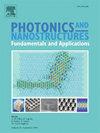用于检测多种癌症和传染病的高灵敏度折射率太赫兹超表面生物传感器
IF 2.9
3区 物理与天体物理
Q3 MATERIALS SCIENCE, MULTIDISCIPLINARY
Photonics and Nanostructures-Fundamentals and Applications
Pub Date : 2025-05-13
DOI:10.1016/j.photonics.2025.101399
引用次数: 0
摘要
尽管取得了显著的进展,但许多现有的太赫兹生物传感器依赖于昂贵的材料,如贵金属或二维纳米材料,并且通常仅限于检测特定的生物标志物或单一疾病,这限制了它们的特异性、适应性和现实世界的临床实用性。这项工作通过提出一种成本效益高、可扩展的基于铝和聚酰亚胺折射率的超表面生物传感器设计来解决这些限制。通过双共振机制,传感器捕捉到与多种疾病相关的微小介电变化,包括乳腺癌、血癌和宫颈癌等癌症,以及疟疾等与血液相关的感染。在优化的仿真条件下,该传感器的质量因数超过200,优点系数为63.68 RIU⁻¹ ,灵敏度为3.107 THz/RIU。除了其强大的性能指标外,该传感器还提供了一个具有成本效益和非侵入性的检测平台,无缝集成了简单性,对多种疾病的适应性和高诊断精度,在广泛的生物医学应用中推进了早期,快速和可获得的诊断领域,特别是在资源有限的环境中。本文章由计算机程序翻译,如有差异,请以英文原文为准。
High-sensitivity refractive index based terahertz metasurface biosensor for detecting multiple cancers and infectious diseases
Despite notable progress, many existing terahertz biosensors rely on expensive materials like noble metals or 2D nanomaterials and are typically restricted to detecting specific biomarkers or single diseases, which limits their specificity, adaptability and real-world clinical utility. This work addresses these limitations by proposing a cost-effective, scalable refractive index based metasurface biosensor design that is composed of Aluminum and Polyimide. Through a dual-resonance mechanism, the sensor captures minute dielectric variations linked to multiple diseases including cancers such as breast, blood and cervical, as well as blood related infections like malaria. Under optimized simulation conditions, the sensor shows a high-Quality Factor exceeding 200, a Figure of Merit of 63.68 RIU⁻¹ and a sensitivity of 3.107 THz/RIU. Beyond its strong performance metrics, the sensor provides a cost-effective and non-invasive detection platform that seamlessly integrates simplicity, adaptability to multiple diseases and high diagnostic precision, advancing the field of early, rapid and accessible diagnostics across a wide range of biomedical applications, especially in resource limited settings.
求助全文
通过发布文献求助,成功后即可免费获取论文全文。
去求助
来源期刊
CiteScore
5.00
自引率
3.70%
发文量
77
审稿时长
62 days
期刊介绍:
This journal establishes a dedicated channel for physicists, material scientists, chemists, engineers and computer scientists who are interested in photonics and nanostructures, and especially in research related to photonic crystals, photonic band gaps and metamaterials. The Journal sheds light on the latest developments in this growing field of science that will see the emergence of faster telecommunications and ultimately computers that use light instead of electrons to connect components.

 求助内容:
求助内容: 应助结果提醒方式:
应助结果提醒方式:


